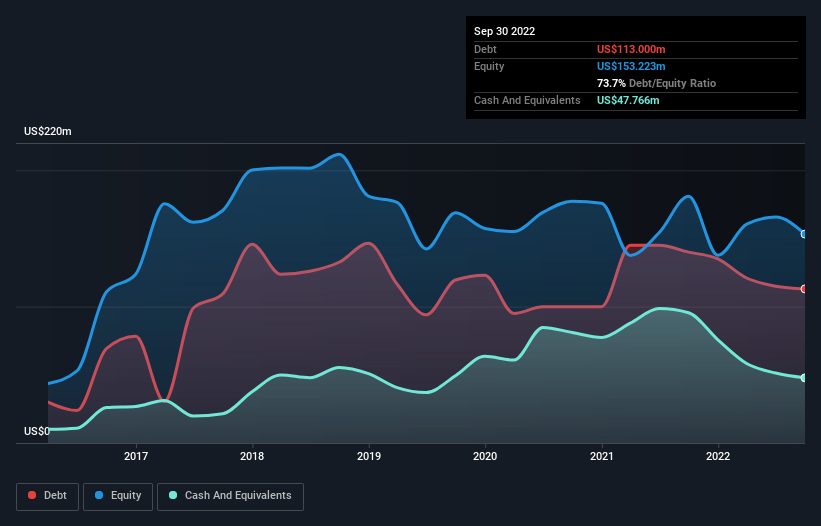- United States
- /
- Electric Utilities
- /
- NasdaqGS:VIA
We Think Via Renewables (NASDAQ:VIA) Has A Fair Chunk Of Debt
Howard Marks put it nicely when he said that, rather than worrying about share price volatility, 'The possibility of permanent loss is the risk I worry about... and every practical investor I know worries about.' So it seems the smart money knows that debt - which is usually involved in bankruptcies - is a very important factor, when you assess how risky a company is. As with many other companies Via Renewables, Inc. (NASDAQ:VIA) makes use of debt. But the more important question is: how much risk is that debt creating?
What Risk Does Debt Bring?
Debt assists a business until the business has trouble paying it off, either with new capital or with free cash flow. In the worst case scenario, a company can go bankrupt if it cannot pay its creditors. However, a more common (but still painful) scenario is that it has to raise new equity capital at a low price, thus permanently diluting shareholders. Of course, plenty of companies use debt to fund growth, without any negative consequences. When we examine debt levels, we first consider both cash and debt levels, together.
View our latest analysis for Via Renewables
What Is Via Renewables's Debt?
You can click the graphic below for the historical numbers, but it shows that Via Renewables had US$113.0m of debt in September 2022, down from US$140.0m, one year before. However, it also had US$47.8m in cash, and so its net debt is US$65.2m.

How Healthy Is Via Renewables' Balance Sheet?
Zooming in on the latest balance sheet data, we can see that Via Renewables had liabilities of US$56.1m due within 12 months and liabilities of US$118.8m due beyond that. On the other hand, it had cash of US$47.8m and US$62.4m worth of receivables due within a year. So it has liabilities totalling US$64.8m more than its cash and near-term receivables, combined.
Via Renewables has a market capitalization of US$232.1m, so it could very likely raise cash to ameliorate its balance sheet, if the need arose. However, it is still worthwhile taking a close look at its ability to pay off debt. When analysing debt levels, the balance sheet is the obvious place to start. But you can't view debt in total isolation; since Via Renewables will need earnings to service that debt. So if you're keen to discover more about its earnings, it might be worth checking out this graph of its long term earnings trend.
Over 12 months, Via Renewables reported revenue of US$443m, which is a gain of 7.6%, although it did not report any earnings before interest and tax. That rate of growth is a bit slow for our taste, but it takes all types to make a world.
Caveat Emptor
Over the last twelve months Via Renewables produced an earnings before interest and tax (EBIT) loss. Its EBIT loss was a whopping US$64m. Considering that alongside the liabilities mentioned above does not give us much confidence that company should be using so much debt. So we think its balance sheet is a little strained, though not beyond repair. For example, we would not want to see a repeat of last year's loss of US$3.5m. So to be blunt we do think it is risky. When analysing debt levels, the balance sheet is the obvious place to start. However, not all investment risk resides within the balance sheet - far from it. For instance, we've identified 2 warning signs for Via Renewables that you should be aware of.
At the end of the day, it's often better to focus on companies that are free from net debt. You can access our special list of such companies (all with a track record of profit growth). It's free.
New: Manage All Your Stock Portfolios in One Place
We've created the ultimate portfolio companion for stock investors, and it's free.
• Connect an unlimited number of Portfolios and see your total in one currency
• Be alerted to new Warning Signs or Risks via email or mobile
• Track the Fair Value of your stocks
Have feedback on this article? Concerned about the content? Get in touch with us directly. Alternatively, email editorial-team (at) simplywallst.com.
This article by Simply Wall St is general in nature. We provide commentary based on historical data and analyst forecasts only using an unbiased methodology and our articles are not intended to be financial advice. It does not constitute a recommendation to buy or sell any stock, and does not take account of your objectives, or your financial situation. We aim to bring you long-term focused analysis driven by fundamental data. Note that our analysis may not factor in the latest price-sensitive company announcements or qualitative material. Simply Wall St has no position in any stocks mentioned.
About NasdaqGS:VIA
Via Renewables
Through its subsidiaries, operates as an independent retail energy services company in the United States.
Flawless balance sheet and good value.
Similar Companies
Market Insights
Community Narratives



